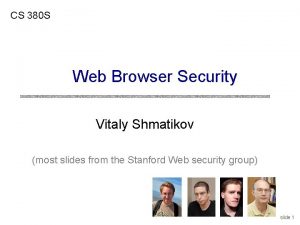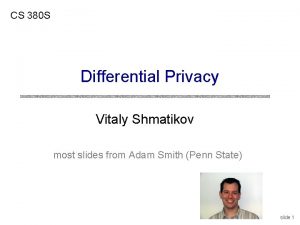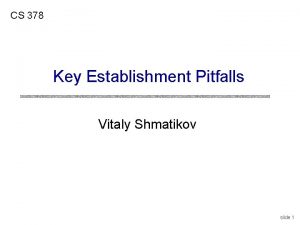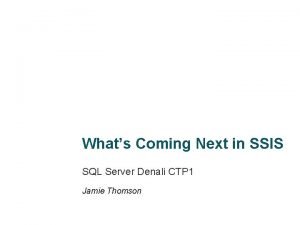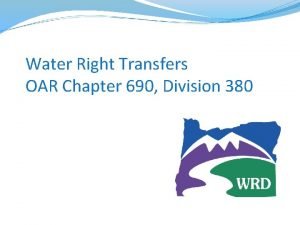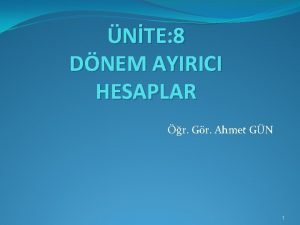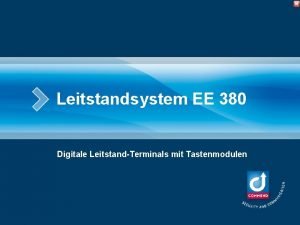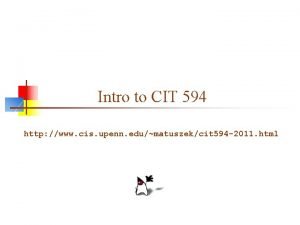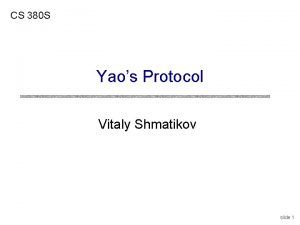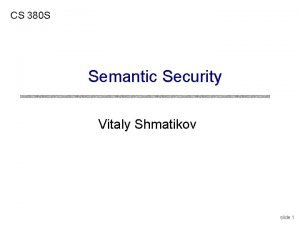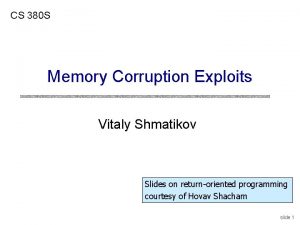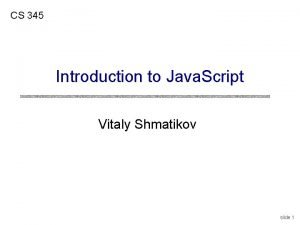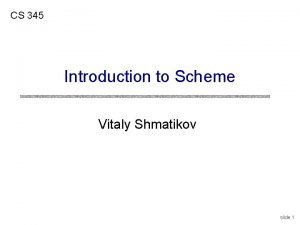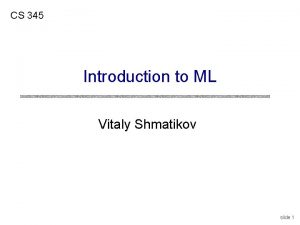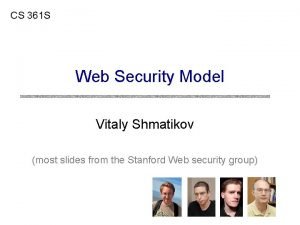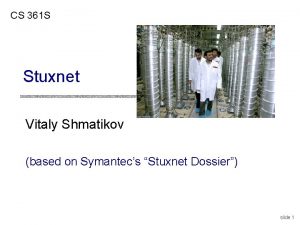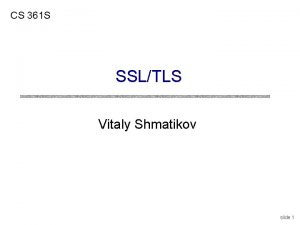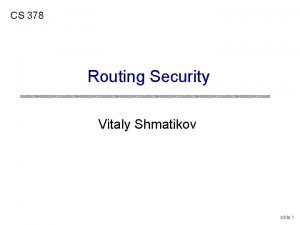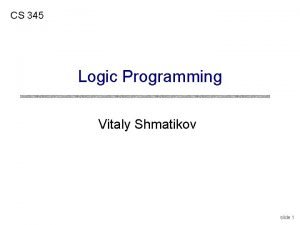CS 380 S Introduction to ZeroKnowledge Vitaly Shmatikov















- Slides: 15

CS 380 S Introduction to Zero-Knowledge Vitaly Shmatikov slide 1

Commitment u. Temporarily hide a value, but ensure that it cannot be changed later • Example: sealed bid at an auction u 1 st stage: commit • Sender electronically “locks” a message in a box and sends the box to the Receiver u 2 nd stage: reveal • Sender proves to the Receiver that a certain message is contained in the box slide 2

Properties of Commitment Schemes u. Commitment must be hiding • At the end of the 1 st stage, no adversarial receiver learns information about the committed value • If receiver is probabilistic polynomial-time, then computationally hiding; if receiver has unlimited computational power, then perfectly hiding u. Commitment must be binding • At the end of the 2 nd stage, there is only one value that an adversarial sender can successfully “reveal” • Perfectly binding vs. computationally binding u. Can a scheme be perfectly hiding and binding? slide 3

Discrete Logarithm Problem u. Intuitively: given gx mod p where p is a large prime, it is “difficult” to learn x • Difficult = there is no known polynomial-time algorithm ug is a generator of a multiplicative group Zp* • Fermat’s Little Theorem – For any integer a and any prime p, ap-1=1 mod p. • g 0, g 1 … gp-2 mod p is a sequence of distinct numbers, in which every integer between 1 and p-1 occurs once – For any number y [1. . p-1], x s. t. gx = y mod p • If gq=1 for some q>0, then g is a generator of Zq, an order-q subgroup of Zp* slide 4

Pedersen Commitment Scheme u. Setup: receiver chooses… • • Large primes p and q such that q divides p-1 Generator g of the order-q subgroup of Zp* Random secret a from Zq h=ga mod p – Values p, q, g, h are public, a is secret u. Commit: to commit to some x Zq, sender chooses random r Zq and sends c=gxhr mod p to receiver • This is simply gx(ga)r=gx+ar mod p u. Reveal: to open the commitment, sender reveals x and r, receiver verifies that c=gxhr mod p slide 5

Security of Pedersen Commitments u. Perfectly hiding • Given commitment c, every value x is equally likely to be the value commited in c • Given x, r and any x’, exists r’ such that gxhr = gx’hr’ r’ = (x-x’)a-1 + r mod q (but must know a to compute r’) u. Computationally binding • If sender can find different x and x’ both of which open commitment c=gxhr, then he can solve discrete log – – Suppose sender knows x, r, x’, r’ s. t. gxhr = gx’hr’ mod p Because h=ga mod p, this means x+ar = x’+ar’ mod q Sender can compute a as (x’-x)(r-r’)-1 But this means sender computed discrete logarithm of h! slide 6

Zero-Knowledge Proofs u. An interactive proof system involves a prover and a verifier u. Idea: the prover proves a statement to the verifier without revealing anything except the fact that the statement is true • Zero-knowledge proof of knowledge (ZKPK): prover convinces verifier that he knows a secret without revealing the secret u. Ideal functionality Is this true? Yes! slide 7

Properties of ZKPK u. Completeness • If both prover and verifier are honest, protocol succeeds with overwhelming probability u. Soundness • No one who does not know the secret can convince the verifier with nonnegligible probability – Intuition: the protocol should not enable prover to prove a false statement u. Zero knowledge • The proof does not leak any information slide 8

Zero-Knowledge Property u. The proof does not leak any information u. There exists a simulator that, taking what the verifier knows before the protocol starts, produces a fake “transcript” of protocol messages that is indistinguishable from actual protocol messages • Because all messages can be simulated from verifier’s initial knowledge, verifier does not learn anything that he didn’t know before • Indistinguishability: perfect, statistical, or computational u. Honest-verifier ZK only considers verifiers that follow the protocol slide 9

Soundness Property u. No one who does not know the secret can convince the verifier with nonnegligible probability u. Let A be any prover who convinces the verifier… u…there must exist a knowledge extractor algorithm that, given A, extracts the secret from A • Intuition: if there existed some prover A who manages to convince the verifier that he knows the secret without actually knowing it, then no algorithm could possibly extract the secret from this A slide 10

Schnorr’s Id Protocol u. System parameters • Prime p and q such that q divides p-1 • g is a generator of an order-q subgroup of Zp* Knows s such that t=gs mod p Wants to prove this fact to V Chooses random r in [1. . q] P Knows t x = gr mod p c Chooses random c in [1. . 2 n] y = r+sc V Verifies x= gyt-c mod p P proves that he knows discrete log of t without revealing its value = gr+sc(gs)-c mod p = gr mod p slide 11

Cheating Sender u. Prover can cheat if he can guess c in advance • Guess c, set x=gyt-c for random y in 1 st message • What is the probability of guessing c? x=gyt-c Chooses random r in [1. . q] x = gr mod p P c Chooses random c in [1. . 2 n] y V Verifies x= gyt-c mod p P proves that he “knows” discrete log of t even though he does not know s slide 12

Schnorr’s Id Protocol Is Sound u. Given P who successfully passes the protocol, extract s such that t=gs mod p Knows t • Idea: run P twice as a subroutine x Chooses random c in [1. . 2 ] c 1 y 1 such that x=gy 1 t-c 1 1 P “rewind” P c 2 n Chooses random c 2 in [1. . 2 n] Ext y 2 such that x=gy 2 t-c 2 Compute s=(y 1 -y 2)(c 1 -c 2)-1 gy 1 t-c 1 = gy 2 t-c 2 implies gy 1 -y 2= tc 1 -c 2 Therefore, gy 1 -y 2(c 1 -c 2)-1 =t slide 13

Schnorr’s Id Protocol Is HVZK u. Simulator produces a transcript which is indistinguishable from the real transcript Simulated transcript Pick random c and y gyt-c c y Does not know s such that t=gs mod p (why? ) Sim P Real transcript x c y Pick random c in [1. . 2 n] such that x=gyt-c V These transcripts are indistinguishable Schnorr’s ID protocol is honest-verifier zero-knowledge … but only if c in the real protocol is indeed random (verifier must run the protocol honestly) slide 14

Schnorr’s Id Protocol Is Not ZK u. Schnorr’s ID protocol is not zero-knowledge for malicious verifier if challenge c is large P x c y Pick some c (may depend on x) such that x=gyt-c V Triple (x, c, y) is a solution to the equation x=gyt-c Verifier may not be able to come up with such a triple on his own. Therefore, he learned something from the protocol (protocol is not zero-knowledge!) slide 15
